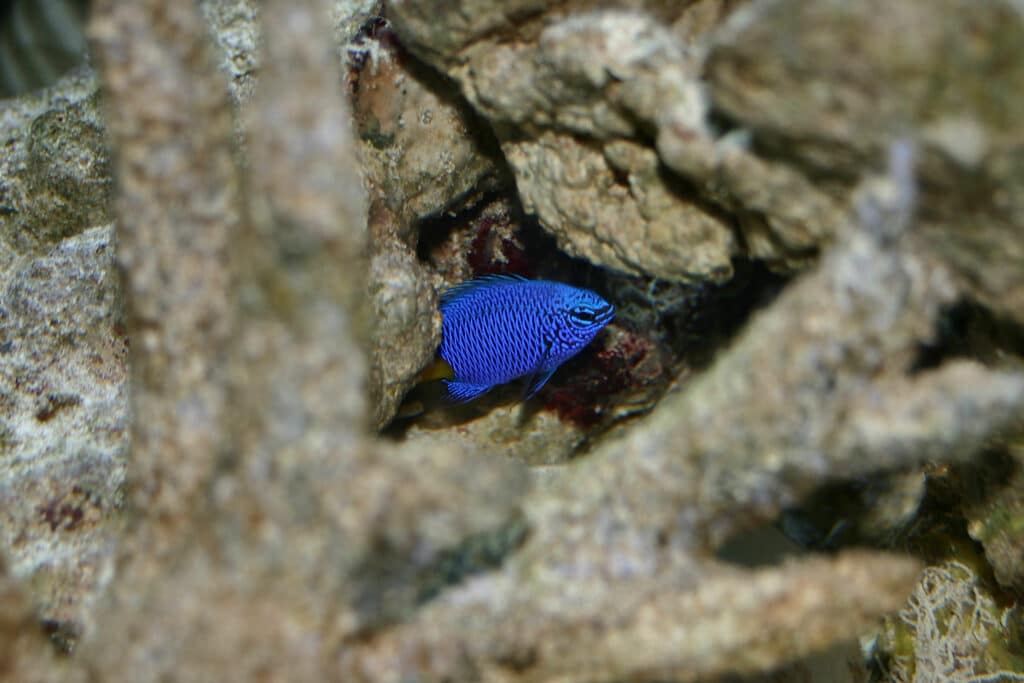Chalice Coral: A Comprehensive Guide for Beginners
Corals are not just beautiful creatures that add color to an underwater world, but they also play a vital role...
Jim Sabellico
January 12, 2022

Setting up a successful reef tank requires a certain degree of both preparation and maintenance, but it does not have to be a highly complex task. We have rounded up some of our top techniques to effortlessly navigate the first few weeks with your new saltwater tank as you take it through it’s cycling process.
By now you have likely heard of the term ‘cycling’ a saltwater aquarium. This term essentially refers to the process of natural filtration that ensures your tank is free of toxic waste gets it ready for stocking with fish and coral. This is primarily conducted by the introduction of beneficial bacteria into the tank to break down harmful toxins that when accumulated over time pose a significant threat to marine plants and animals.
This process is known as the nitrogen cycle and the beneficial bacteria works to break down harmful ammonia (NH3, into nitrate (NO2) and subsequently into nitrate (NO3).
Ok, now that we have the science out of the way – how do total beginners attempt to kickstart this process at home? The aquarium hobby is often referred to as a slow burn – and some of you will already know this. But for those of you who don’t – cycling your tank can take anywhere from 2-6 weeks. The length of the process will normally depend on both the materials available to you and also the effort exerted throughout the course of the cycle.
Live sand and live rock will be your best friend throughout this cycle.
What live sand and live rock refer to is sand or rock that has been used in a running reef system for a period of time, typically 6 months or more, and this sand or rock has beneficial bacteria already living inside of it’s porous surfaces, or on it. This beneficial bacteria can help you jump-start the process of your reef tank cycling because you are already introducing this into your system at an early stage, instead of having to start with dry rock or sand, which is like it sounds, rock or sand that is stored out of water and has no living organisms on it.
We recommend starting out with live rock and live sand – which can be sourced at most local fish/pet stores – particularly those specializing in reef tank equipment. If you are a seasoned member of the aquarium community – you may have alternative sources in acquaintances or experts that can help in this area.
If you are sourcing live rock from outside an accredited fish store – be sure the rock has been stored in a tank for a minimum of six months. Be aware of any algae or pests present on the rock that may compromise your cycle. If you suspect there are unwanted growths on your live rock be sure to consult an expert directly.
Once you have your live sand and live rock in your tank (your tank should be full of saltwater now too) we can move on to the next part.
After roughly seven days – you will introduce a source of ammonia into your tank. This will help to move the cycle along and is a necessary part of the process to spark the bacteria which will help convert that ammonia.
A lot of old-school reefers will recommend adding in some really hardy fish such as Damsels at this stage, because they are typically strong enough to survive the fluctuations in poor water quality and they will naturally create that ammonia as a byproduct of their feeding. Once fed, these animals will begin to produce ammonia into the tank and the next phase of the cycle is initiated.
However – using live animals for this stage of the cycle isn’t really the best idea as it can be really stressful for the fish, often resulting in death, and assuming they do survive, it can often be hard to get them back out of your tank if you aren’t planning on having them as part of your reef long term.
A better way to do this is by either doing ghost feedings, which is basically feeding your tank is if there were fish in it, but really you’re just letting the food circulate and decay, or some people also will put a cooked shrimp in the tank, again, just letting it decay in the tank and causing that ammonia to build up.
Ammonia (NH3) is an essential component in the process as it allows the bacteria present on the liverock to begin working their magic. In essence, ammonia enables the bacteria to populate your tank creating the optimum environment for marine life.
Once your reef tank is past the cycle, ammonia is not something we ever really want to see again, it’s only in this current stage where we want to see a spike in ammonia as it kicks off the next phase of the cycling process to create all the beneficial bacteria we need to survive.
AMMONIA → NITRITES → NITRATES
The sequence chemical compounds present appear in are indicated above, and if you’ve done the first steps correctly, you should start to see your Nitrite and Nitrate levels begin to change.
Throughout this process, it’s important to be doing frequent water tests. This will help give you a more complete picture of what is happening inside your water so you can better understand what part of the cycle you’re in currently.
After Ammonia has risen, you’ll see it fall back down to zero and nitrites will rise. Once nitrites spike, they should then fall back down and nitrates will rise.
Once nitrate appears – levels of ammonia and nitrites will dissipate and your tank is now deemed a safe environment for marine life. Note: ammonia and nitrite levels must drop to zero before the nitrogen cycle is deemed complete. We recommend using an ‘Ammonia Alert’ device by Seachem to track changes to ammonia levels throughout this process.
Nitrate levels should only be present in very small quantities. 5ppm or below is optimum for a tank containing reef, whereas 40ppm can be observed for tanks containing fish only. This number may vary though, as some people have been successful keeping a higher nitrate number, each tank is different,but in general, you want to keep it low.
As mentioned, fish are ammonia-producing and ammonia-consuming creatures – therefore we always recommend waiting until the nitrogen cycle has been completed to add fish to the tank.
This is because both fish food and fish waste contain ammonia-producing properties and may interfere with the process by the overproduction of ammonia at a single interval. However, this risk does not vanish once the nitrogen cycle is over, and it is often advised that one fish is introduced into the tank at a given time to avoid an overproduction of ammonia and to allow the tank time to regulate.
The good news is that this cycle is less about reinventing the wheel than it is a game of patience.
The process itself is not designed to overwhelm the aquarium aficionado but to make sure you are getting the most from your materials and of course your marine life. Some people can feel they are waiting days or even weeks for the desired results, but it is all part of the process.
If you are getting impatient, remember you want your coral and animals to THRIVE, and the cycle process is central to this outcome. It is crucial that caution is exercised at every stage of the nitrogen cycle, not only to protect your maritime friends but to protect your health and wellbeing also.
Whatever stage of your aquarium journey you find yourself in – we hope you have gathered some helpful tips on the nitrogen cycle and are clear as to its crucial significance in the saltwater aquarium hobby.
And don’t forget, the most important thing during this process is to remain patient. We know starting up a new tank is exciting and you can be eager to fill it right away with pretty coral and fish, but your patience will be rewarded here.
Happy Cycling!

I am the founder of J. Louis, a digital marketing agency focused on providing innovative solutions and strategies built on a foundation of creative design and technology. A family man who loves travel and reef tanks, I’ve been coined as a jack of all trades, master of a few of them, most specifically website and sales funnel design, monetization and growth strategies, and viral marketing. I began pursuing my passions for business by cutting my neighbor’s lawns when I was just 8 years old and never looked back. Over the past 20 years, I have amassed significant experience providing consulting, design and development services for Fortune 500 companies, government, retail, private individuals, and A-list celebrities.
Corals are not just beautiful creatures that add color to an underwater world, but they also play a vital role...
As we move into the new year, it's time to start thinking about what reef tank LED lighting kits will...

Proceeds from all purchases go directly to Great Barrier Reef Foundation and supporting their mission.
Want to stay connected with all the latest news in the Reef Tank Addict community? Drop your email below!
Proudly Supporting The Great Barrier Reef Foundation
Copyright © 2023. All rights reserved.